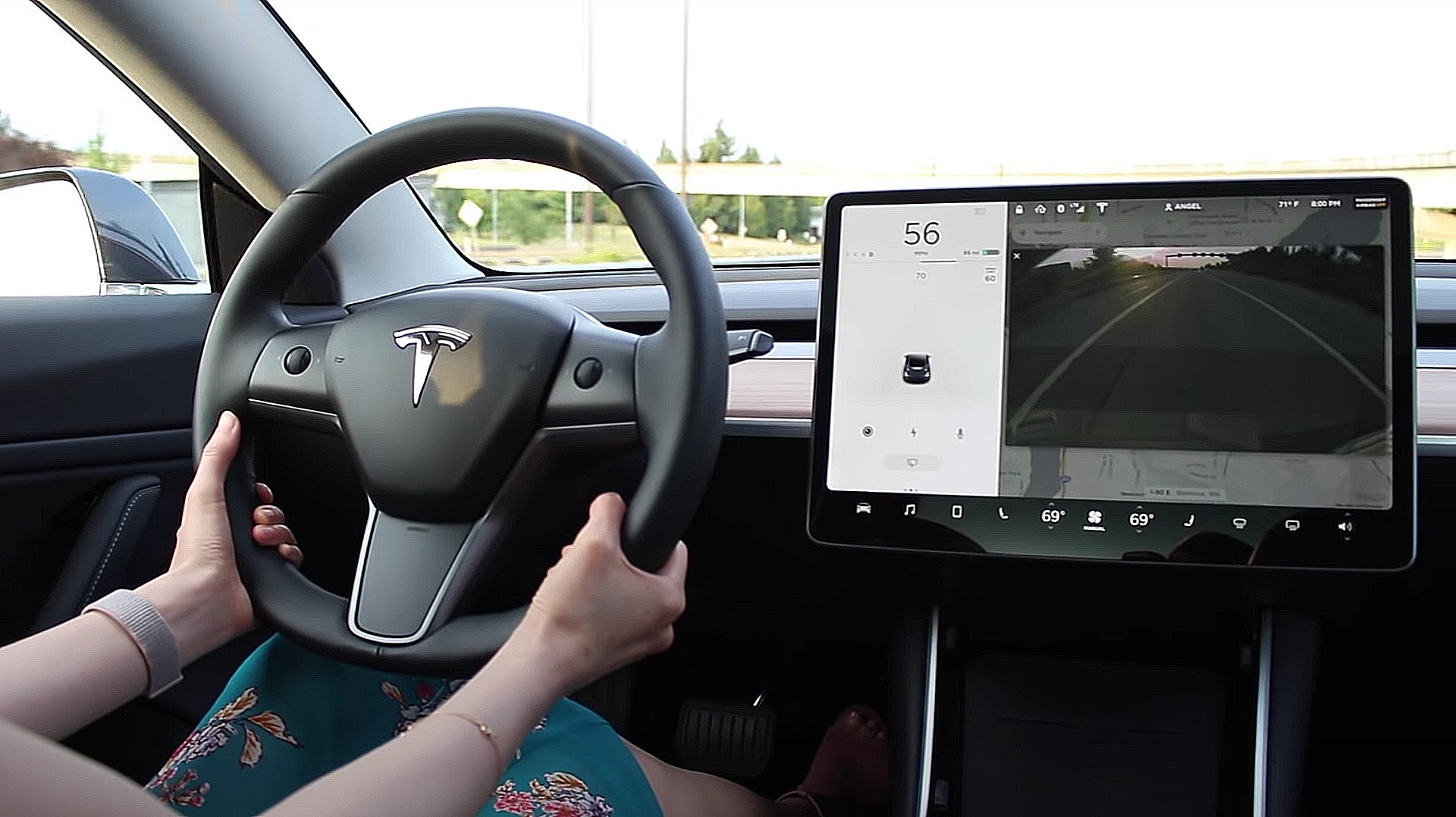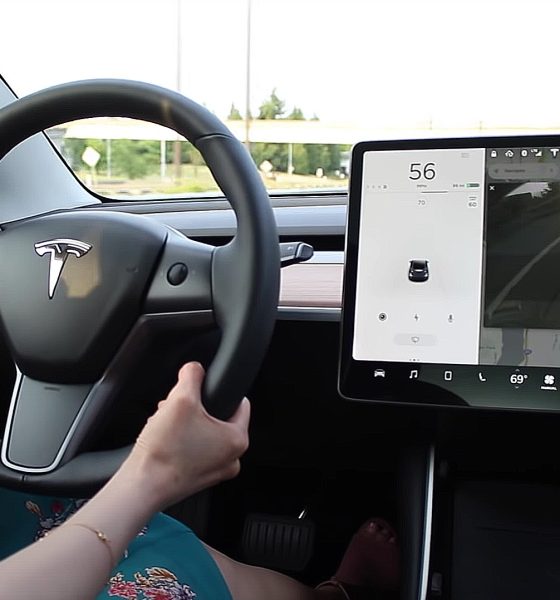The first report of an accident involving a vehicle that uses Tesla’s Full Self-Driving Beta is being looked at by the National Highway Traffic Safety Administration (NHTSA). The accident is currently not under a formal investigation by the NHTSA, but the agency did state that it is “gathering information” related to the incident.
A Tesla Model Y enrolled in the FSD Beta program reportedly took a left turn and drove into the wrong lane. The Model Y was struck by another vehicle, and the driver states that they tried to regain control of the car to correct the maneuver. “The Vehicle was in FSD Beta mode, and while taking a left turn, the car went into the wrong lane, and I was hit by another driver in the lane next to my lane. The car gave an alert 1/2 way through the turn, so I tried to turn the wheel to avoid it from going into the wrong lane,” the Model Y owner wrote. However, it was too late, and “the car by itself took control and forced itself into the incorrect lane creating an unsafe manner putting everyone involved at risk,” according to the owner’s account.
Tesla FSD Beta crash report posted on NHTSA website, claims car fought for control
The NHTSA confirmed to Teslarati that it was “gathering information” on the incident and had reached out to the electric automaker for information. Details of the accident first appeared on the NHTSA website on November 8, although the accident occurred on November 3. The NHTSA monitors the list of complaints filed with the agency, and incidents that are unable to be confirmed are removed from the list. However, this accident was confirmed, and the NHTSA is looking into the situation.
As previously mentioned, the NHTSA has not launched a formal investigation into the accident.
The NHTSA told Teslarati:
“NHTSA is aware of the consumer complaint in question and is in communication with the manufacturer to gather additional information. NHTSA encourages the public to report any safety concerns to the agency at nhtsa.gov or by calling the Vehicle Safety Hotline at 888-327-4236.”
Additionally, the NHTSA clarified that it does hold differences between “gathering information” and “investigating” an incident. The agency told us that this incident is not under formal investigation.
The accident occurred in Brea, California, a city in Northern Orange County with about 43,000 people.
For the last few months, Tesla has expanded its FSD Beta fleet and has been extremely cautious and conservative with adding new drivers. The FSD Beta fleet only features drivers with Safety Scores between 99 and 100, which Tesla owners have stated on numerous occasions are hard scores to come by.
It is also important to note that vehicles utilizing Tesla’s semi-autonomous driving features are involved in accidents significantly less often than other vehicles. According to Tesla’s most recent Safety Report, which was released in Q2, vehicles using Autopilot technology were involved in one crash every 4.41 million miles. According to the NHTSA’s most recent data, the national average shows that there is one automobile accident every 484,000 miles.
I’d love to hear from you! If you have any comments, concerns, or questions, please email me at joey@teslarati.com. You can also reach me on Twitter @KlenderJoey, or if you have news tips, you can email us at tips@teslarati.com.

News
Tesla FSD fleet is nearing 7 billion total miles, including 2.5 billion city miles
As can be seen on Tesla’s official FSD webpage, vehicles equipped with the system have now navigated over 6.99 billion miles.

Tesla’s Full Self-Driving (Supervised) fleet is closing in on almost 7 billion total miles driven, as per data posted by the company on its official FSD webpage.
These figures hint at the massive scale of data fueling Tesla’s rapid FSD improvements, which have been quite notable as of late.
FSD mileage milestones
As can be seen on Tesla’s official FSD webpage, vehicles equipped with the system have now navigated over 6.99 billion miles. Tesla owner and avid FSD tester Whole Mars Catalog also shared a screenshot indicating that from the nearly 7 billion miles traveled by the FSD fleet, more than 2.5 billion miles were driven inside cities.
City miles are particularly valuable for complex urban scenarios like unprotected turns, pedestrian interactions, and traffic lights. This is also the difference-maker for FSD, as only complex solutions, such as Waymo’s self-driving taxis, operate similarly on inner-city streets. And even then, incidents such as the San Francisco blackouts have proven challenging for sensor-rich vehicles like Waymos.
Tesla’s data edge
Tesla has a number of advantages in the autonomous vehicle sector, one of which is the size of its fleet and the number of vehicles training FSD on real-world roads. Tesla’s nearly 7 billion FSD miles then allow the company to roll out updates that make its vehicles behave like they are being driven by experienced drivers, even if they are operating on their own.
So notable are Tesla’s improvements to FSD that NVIDIA Director of Robotics Jim Fan, after experiencing FSD v14, noted that the system is the first AI that passes what he described as a “Physical Turing Test.”
“Despite knowing exactly how robot learning works, I still find it magical watching the steering wheel turn by itself. First it feels surreal, next it becomes routine. Then, like the smartphone, taking it away actively hurts. This is how humanity gets rewired and glued to god-like technologies,” Fan wrote in a post on X.
News
Tesla starts showing how FSD will change lives in Europe
Local officials tested the system on narrow country roads and were impressed by FSD’s smooth, human-like driving, with some calling the service a game-changer for everyday life in areas that are far from urban centers.

Tesla has launched Europe’s first public shuttle service using Full Self-Driving (Supervised) in the rural Eifelkreis Bitburg-Prüm region of Germany, demonstrating how the technology can restore independence and mobility for people who struggle with limited transport options.
Local officials tested the system on narrow country roads and were impressed by FSD’s smooth, human-like driving, with some calling the service a game-changer for everyday life in areas that are far from urban centers.
Officials see real impact on rural residents
Arzfeld Mayor Johannes Kuhl and District Administrator Andreas Kruppert personally tested the Tesla shuttle service. This allowed them to see just how well FSD navigated winding lanes and rural roads confidently. Kruppert said, “Autonomous driving sounds like science fiction to many, but we simply see here that it works totally well in rural regions too.” Kuhl, for his part, also noted that FSD “feels like a very experienced driver.”
The pilot complements the area’s “Citizen Bus” program, which provides on-demand rides for elderly residents who can no longer drive themselves. Tesla Europe shared a video of a demonstration of the service, highlighting how FSD gives people their freedom back, even in places where public transport is not as prevalent.
What the Ministry for Economic Affairs and Transport says
Rhineland-Palatinate’s Minister Daniela Schmitt supported the project, praising the collaboration that made this “first of its kind in Europe” possible. As per the ministry, the rural rollout for the service shows FSD’s potential beyond major cities, and it delivers tangible benefits like grocery runs, doctor visits, and social connections for isolated residents.
“Reliable and flexible mobility is especially vital in rural areas. With the launch of a shuttle service using self-driving vehicles (FSD supervised) by Tesla in the Eifelkreis Bitburg-Prüm, an innovative pilot project is now getting underway that complements local community bus services. It is the first project of its kind in Europe.
“The result is a real gain for rural mobility: greater accessibility, more flexibility and tangible benefits for everyday life. A strong signal for innovation, cooperation and future-oriented mobility beyond urban centers,” the ministry wrote in a LinkedIn post.
News
Tesla China quietly posts Robotaxi-related job listing
Tesla China is currently seeking a Low Voltage Electrical Engineer to work on circuit board design for the company’s autonomous vehicles.

Tesla has posted a new job listing in Shanghai explicitly tied to its Robotaxi program, fueling speculation that the company is preparing to launch its dedicated autonomous ride-hailing service in China.
As noted in the listing, Tesla China is currently seeking a Low Voltage Electrical Engineer to work on circuit board design for the company’s autonomous vehicles.
Robotaxi-specific role
The listing, which was shared on social media platform X by industry watcher @tslaming, suggested that Tesla China is looking to fill the role urgently. The job listing itself specifically mentions that the person hired for the role will be working on the Low Voltage Hardware team, which would design the circuit boards that would serve as the nervous system of the Robotaxi.
Key tasks for the role, as indicated in the job listing, include collaboration with PCB layout, firmware, mechanical, program management, and validation teams, among other responsibilities. The role is based in Shanghai.
China Robotaxi launch
China represents a massive potential market for robotaxis, with its dense urban centers and supportive policies in select cities. Tesla has limited permission to roll out FSD in the country, though despite this, its vehicles have been hailed as among the best in the market when it comes to autonomous features. So far, at least, it appears that China supports Tesla’s FSD and Robotaxi rollout.
This was hinted at in November, when Tesla brought the Cybercab to the 8th China International Import Expo (CIIE) in Shanghai, marking the first time that the autonomous two-seater was brought to the Asia-Pacific region. The vehicle, despite not having a release date in China, received a significant amount of interest among the event’s attendees.










